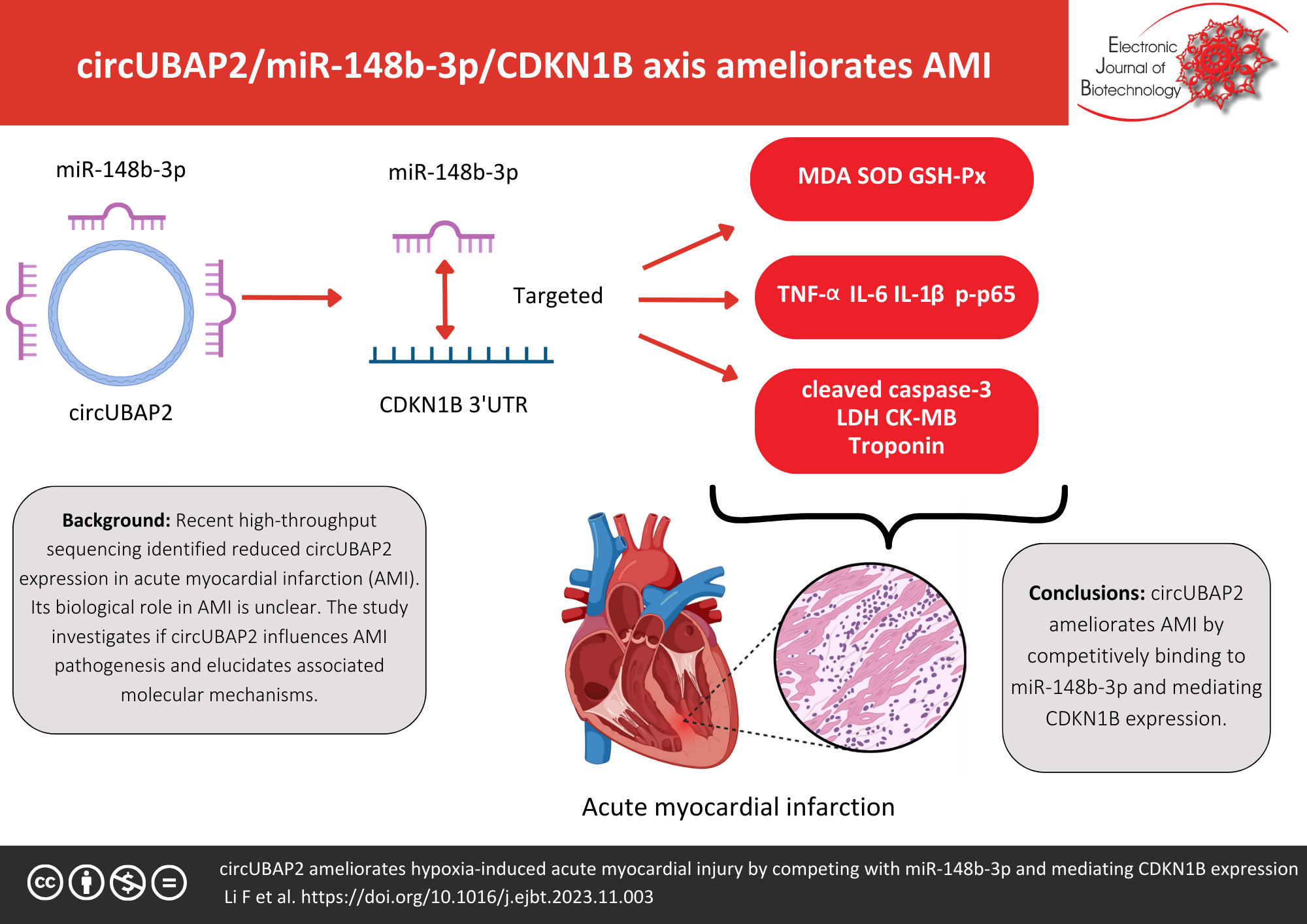Abstract
Background: A recent high-throughput sequencing study revealed an anomalous underexpression of circular RNA UBAP2 (circUBAP2) in acute myocardial infarction (AMI), yet its biological function within this context remains elusive. This study aims to unravel whether circUBAP2 is instrumental in modulating the pathogenesis of AMI and to illuminate the underlying molecular mechanisms at play.
Results: circUBAP2 was abnormally low expressed in AMI. Inducing circUBAP2 ameliorated hypoxia-induced myocardial cell injury by enhancing cellular viability, and decreasing lactate dehydrogenase release, apoptosis, inflammation, and oxidative damage. circUBAP2 targeted miR-148b-3p, miR-148b-3p overexpression offset circUBAP2-induced cardioprotection. Cyclin-dependent kinase inhibitor 1B (CDKN1B) was mediated by miR-148b-3p, and CDKN1B upregulation suppressed the deleterious effect of circUBAP2 silencing on hypoxic AC16 cells. In addition, overexpression of circUBAP2 improved myocardial injury, decreased myocardial cell apoptosis, and alleviated inflammation and oxidative stress in AMI mice.
Conclusions: circUBAP2 ameliorates AMI by competitively binding to miR-148b-3p and mediating CDKN1B expression.
References
Colombo A, Proietti R, ?uli? V, et al. Triggers of acute myocardial infarction: A neglected piece of the puzzle. J Cardiovasc Med 2014;15(1):1-7. https://doi.org/10.2459/JCM.0b013e3283641351 PMid: 24500234
Bajaj A, Sethi A, Rathor P, et al. Acute complications of myocardial infarction in the current era: Diagnosis and management. J Investig Med. 2015;63(7):844-55. https://doi.org/10.1097/JIM.0000000000000232 PMid: 26295381
Damluji AA, van Diepen S, Katz JN, et al. Mechanical complications of acute myocardial infarction: A scientific statement from the American Heart Association. Circulation. 2021;144(2):e16-e35. https://doi.org/10.1161/CIR.0000000000000985
Saito Y, Oyama K, Tsujita K, et al. Treatment strategies of acute myocardial infarction: Updates on revascularization, pharmacological therapy, and beyond. J Cardiol. 2023;81(2):168-78. https://doi.org/10.1016/j.jjcc.2022.07.003 PMid: 35882613
Huang A, Zheng H, Wu Z, et al. Circular RNA-protein interactions: functions, mechanisms, and identification. Theranostics. 2020;10(8):3503-17. https://doi.org/10.7150/thno.42174 PMid: 32206104
Zhang S, Wang W, Wu X, et al. Regulatory roles of circular RNAs in coronary artery disease. Mol Ther Nucleic Acids. 2020;21:172-9. https://doi.org/10.1016/j.omtn.2020.05.024 PMid: 32585625
Altesha MA, Ni T, Khan A, et al. Circular RNA in cardiovascular disease. J Cell Physiol. 2019;234(5):5588-600. https://doi.org/10.1002/jcp.27384 PMid: 30341894
Sun J, Yin A, Zhang W, et al. CircUBAP2 inhibits proliferation and metastasis of clear cell renal cell carcinoma via targeting miR-148a-3p/FOXK2 pathway. Cell Transplant. 2020;29:963689720925751. https://doi.org/10.1177/0963689720925751 PMid: 32425115
Li J, Yu Z, Zeng J, et al. Circular RNA UBAP2 (hsa_circ_0007367) correlates with microcirculatory perfusion and predicts outcomes of cardiogenic shock patients undergoing extracorporeal membrane oxygenation support. Shock. 2022;57(6):200-10. https://doi.org/10.1097/SHK.0000000000001937 PMid: 35759302
Wu J, Li C, Lei Z, et al. Comprehensive analysis of circRNA-miRNA-mRNA regulatory network and novel potential biomarkers in acute myocardial infarction. Front Cardiovasc Med. 2022;9:850991. https://doi.org/10.3389/fcvm.2022.850991 PMid: 35872921
Zhou J, He S, Wang B, et al. Construction and bioinformatics analysis of circRNA-miRNA-mRNA network in acute myocardial infarction. Front Genet. 2022;13:854993. https://doi.org/10.3389/fgene.2022.854993 PMid: 35422846
Wang S, Cheng Z, Chen X, et al. Long noncoding RNA SNHG4 attenuates the injury of myocardial infarction via regulating miR-148b-3p/DUSP1 axis. Cardiovasc Ther. 2022;2022:1652315. https://doi.org/10.1155/2022/1652315 PMid: 36545243
Sun M, Zhai M, Zhang N, et al. MicroRNA-148b-3p is involved in regulating hypoxia/reoxygenation-induced injury of cardiomyocytes in vitro through modulating SIRT7/p53 signaling. Chem Biol Interact. 2018;296:211-9. https://doi.org/10.1016/j.cbi.2018.10.003 PMid: 30308185
Rodríguez I, Coto E, Reguero JR, et al. Role of the CDKN1A/p21, CDKN1C/p57, and CDKN2A/p16 genes in the risk of atherosclerosis and myocardial infarction. Cell Cycle. 2007;6(5):620-5. https://doi.org/10.4161/cc.6.5.3927 PMid: 17351341
Zhou N, Huang Q, Cheng W, et al. p27kip1 haploinsufficiency preserves myocardial function in the early stages of myocardial infarction via Atg5?mediated autophagy flux restoration. Mol Med Rep. 2019;20(4):3840-8. https://doi.org/10.3892/mmr.2019.10632
Zhang M, Wang Z, Cheng Q, et al. Circular RNA (circRNA) CDYL induces myocardial regeneration by ceRNA after myocardial infarction. Med Sci Monit. 2020;26:e923188. https://doi.org/10.12659/MSM.923188
Zhu Y, Zhao P, Sun L, et al. Overexpression of circRNA SNRK targets miR-103-3p to reduce apoptosis and promote cardiac repair through GSK3?/?-catenin pathway in rats with myocardial infarction. Cell Death Discov. 2021;7(1):84. https://doi.org/10.1038/s41420-021-00467-3 PMid: 33875647
Zheng G, Huang J, Chen W, et al. circUBAP2 exacerbates malignant capabilities of NSCLC by targeting KLF4 through miR-3182 modulation. Aging 2021;13(8):11083-95. https://doi.org/10.18632/aging.202745 PMid: 33882454
Liu B, Tian Y, Chen M, et al. CircUBAP2 promotes MMP9-mediated oncogenic effect via sponging miR-194-3p in hepatocellular carcinoma. Front Cell Dev Biol. 2021;9:675043. https://doi.org/10.3389/fcell.2021.675043 PMid: 34239873
Yang W, Sun L, Cao X, et al. Detection of circRNA biomarker for acute myocardial infarction based on system biological analysis of RNA expression. Front Genet. 2021;12:686116. https://doi.org/10.3389/fgene.2021.686116 PMid: 33995502
Yang M, Kong DY, Chen JC. Inhibition of miR-148b ameliorates myocardial ischemia/reperfusion injury via regulation of Wnt/?-catenin signaling pathway. J Cell Physiol. 2019;234(10):17757-66. https://doi.org/10.1002/jcp.28401 PMid: 30820984
Chen D, Zhang M. GAS5 regulates diabetic cardiomyopathy via miR-221-3p/p27 axis?associated autophagy. Mol Med Rep. 2021;23(2):135. https://doi.org/10.3892/mmr.2020.11774 PMid: 33313941
Zhang Q, Li D, Zhao H, et al. Decitabine attenuates ischemic stroke by reducing astrocytes proliferation in rats. PLoS One. 2022;17(8):e0272482. https://doi.org/10.1371/journal.pone.0272482 PMid: 35917376

This work is licensed under a Creative Commons Attribution 4.0 International License.
Copyright (c) 2024 Electronic Journal of Biotechnology
